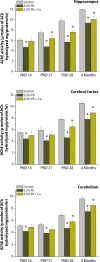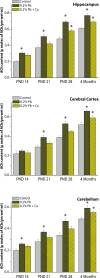Long-term changes in brain cholinergic system and behavior in rats following gestational exposure to lead: protective effect of calcium supplement
- PMID: 27486377
- PMCID: PMC4961914
- DOI: 10.1515/intox-2015-0025
Long-term changes in brain cholinergic system and behavior in rats following gestational exposure to lead: protective effect of calcium supplement
Abstract
Our earlier studies showed that lactational exposure to lead (Pb) caused irreversible neurochemical alterations in rats. The present study was carried out to examine whether gestational exposure to Pb can cause long-term changes in the brain cholinergic system and behavior of rats. The protective effect of calcium (Ca) supplementation against Pb toxicity was also examined. Pregnant rats were exposed to 0.2% Pb (Pb acetate in drinking water) from gestational day (GD) 6 to GD 21. The results showed decrease in body weight gain (GD 6-21) of dams, whereas no changes were observed in offspring body weight at different postnatal days following Pb exposure. Male offspring treated with Pb showed marginal alterations in developmental landmarks such as unfolding of pinnae, lower and upper incisor eruption, fur development, eye slit formation and eye opening on postnatal day (PND) 1, whereas significant alterations were found in the righting reflex (PNDs 4-7), slant board behavior (PNDs 8-10) and forelimb hang performance (PNDs 12-16). Biochemical analysis showed decrease in synaptosomal acetylcholinesterase (AChE) activity and an increase in acetylcholine (ACh) levels in the cortex, cerebellum and hippocampus on PND 14, PND 21, PND 28 and in the four-month age group of rats following Pb exposure. Significant deficits were also observed in total locomotor activity, exploratory behavior and open field behavior in selected age groups of Pb-exposed rats. These alterations were found to be maximal on PND 28, corresponding with the greater blood lead levels observed on PND 28. Addition of 0.02% Ca to Pb reversed the Pb-induced impairments in the cholinergic system as well as in behavioral parameters of rats. In conclusion, these data suggest that gestational exposure to Pb is able to induce long-term changes in neurological functions of offspring. Maternal Ca administration reversed these neurological effects of Pb later in life, suggesting a protective effect of calcium in Pb-exposed animals.
Keywords: behavior; blood Pb levels; calcium supplementation; cholinergic system; lead toxicity; long-term effects.
Figures










Similar articles
-
Perinatal exposure to lead: reduction in alterations of brain mitochondrial antioxidant system with calcium supplement.Biol Trace Elem Res. 2014 Dec;162(1-3):270-7. doi: 10.1007/s12011-014-0112-7. Epub 2014 Aug 28. Biol Trace Elem Res. 2014. PMID: 25161091
-
Perinatal lead exposure alters postnatal cholinergic and aminergic system in rat brain: reversal effect of calcium co-administration.Int J Dev Neurosci. 2012 Jun;30(4):343-50. doi: 10.1016/j.ijdevneu.2012.01.004. Epub 2012 Feb 3. Int J Dev Neurosci. 2012. PMID: 22326442
-
Age related changes in aminergic system and behavior following lead exposure: protection with essential metal supplements.Neurosci Res. 2014 Jan;78:81-9. doi: 10.1016/j.neures.2013.09.007. Epub 2013 Sep 21. Neurosci Res. 2014. PMID: 24064391
-
Effects of combined arsenic and lead exposure on the brain monoaminergic system and behavioral functions in rats: Reversal effect of MiADMSA.Toxicol Ind Health. 2019 Feb;35(2):89-108. doi: 10.1177/0748233718814990. Epub 2018 Dec 10. Toxicol Ind Health. 2019. PMID: 30526433
-
Preweaning behaviors, developmental landmarks, and acrylamide and glycidamide levels after pre- and postnatal acrylamide treatment in rats.Neurotoxicol Teratol. 2010 May-Jun;32(3):373-82. doi: 10.1016/j.ntt.2010.01.010. Epub 2010 Jan 29. Neurotoxicol Teratol. 2010. PMID: 20117204
Cited by
-
Translating Neurobehavioral Toxicity Across Species From Zebrafish to Rats to Humans: Implications for Risk Assessment.Front Toxicol. 2021 Feb 23;3:629229. doi: 10.3389/ftox.2021.629229. eCollection 2021. Front Toxicol. 2021. PMID: 35295117 Free PMC article. Review.
-
Evaluation of Analytes Characterized with Potential Protective Action after Rat Exposure to Lead.Molecules. 2021 Apr 9;26(8):2163. doi: 10.3390/molecules26082163. Molecules. 2021. PMID: 33918725 Free PMC article.
-
Association between heavy metal levels and acute ischemic stroke.J Biomed Sci. 2018 May 25;25(1):49. doi: 10.1186/s12929-018-0446-0. J Biomed Sci. 2018. PMID: 29801491 Free PMC article.
-
The Beneficial Effect of Ononis natrix Against Pb-Induced Sensorimotor, Neurobehavioral, and Oxidative Stress Impairments in Mice Offspring during Gestation and Lactation.Biol Trace Elem Res. 2025 Jun 4. doi: 10.1007/s12011-025-04683-1. Online ahead of print. Biol Trace Elem Res. 2025. PMID: 40464857
-
No association between prenatal lead exposure and neurodevelopment during early childhood in the Japan Environment and Children's Study.Sci Rep. 2022 Sep 12;12(1):15305. doi: 10.1038/s41598-022-19509-6. Sci Rep. 2022. PMID: 36097036 Free PMC article.
References
-
- Augustinson KB. Cholinesterase and anticholinesterase agents. (Ed. G.B. Koelle) Springer Verlag Berlin. 1963;5:89–128.
-
- Ballentine R, Burford DD. Determination of metals. Meth Enzymol. 1957;3:1002–1035.
-
- Basha DC, Rani MU, Devi CB, Kumar MR, Reddy GR. Perinatal lead exposure alters postnatal cholinergic and aminergic system in rat brain: Reversal effect of calcium-co administration. Int J Dev Neursci. 2012;30:343–350. - PubMed
-
- Basha DC, Reddy NS, Rani MU, Reddy GR. Age related changes in aminergic system and behavior following lead exposure: protection with essential metal supplements. Neurosci Res. 2014;78:81–9. - PubMed
-
- Basha MR, Wei W, Brydie M, Razmiafshari M, Zawia NH. Lead induced developmental perturbations in hippocampal Sp1 DNA-binding are prevented by zinc supplementation. Int J Dev Neurosci. 2003;21:1–12. - PubMed
LinkOut - more resources
Full Text Sources
Other Literature Sources
